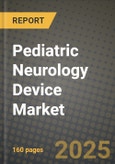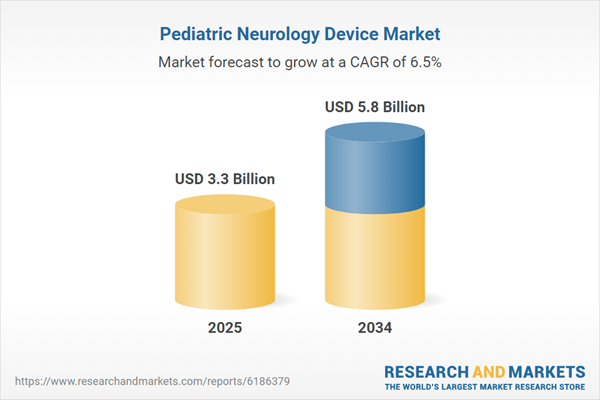Pediatric Neurology Device Market Overview
The pediatric neurology device market is experiencing significant growth due to the rising prevalence of neurological disorders in children, including epilepsy, cerebral palsy, hydrocephalus, and neurodevelopmental disorders. These conditions require specialized diagnostic and treatment devices, such as electroencephalography (EEG) machines, neurostimulation devices, and intracranial pressure monitors, to ensure timely and effective management. Advancements in medical technology, including non-invasive brain monitoring solutions and AI-driven diagnostic tools, are revolutionizing pediatric neurology care. The increasing awareness of early diagnosis and intervention for pediatric neurological conditions is further driving demand for innovative devices. Government initiatives and research funding aimed at improving pediatric neurological care are also contributing to market growth. As healthcare providers focus on precision medicine and personalized treatments, the pediatric neurology device market is expected to expand, offering more effective and child-friendly neurological solutions.The pediatric neurology device market has witnessed major technological advancements, particularly in AI-assisted diagnostic tools that enhance early detection of neurological conditions. Wearable EEG and brain monitoring devices have gained popularity, enabling continuous real-time tracking of neurological activity in pediatric patients. The increased adoption of transcranial magnetic stimulation (TMS) devices for non-invasive treatment of neurological disorders has provided alternative therapeutic options, reducing the reliance on medication. Healthcare providers have also begun integrating virtual reality (VR) and neurofeedback devices into pediatric rehabilitation programs to aid in motor and cognitive development for children with neurological impairments. Additionally, tele-neurology services have expanded, allowing for remote neurological consultations and real-time brain activity monitoring, especially beneficial for children in underserved areas. With continued advancements, pediatric neurology devices are becoming more precise, accessible, and effective.
The pediatric neurology device market is expected to witness further innovation in neurostimulation and brain-computer interface (BCI) technologies. AI-powered predictive analytics will enhance the ability to detect neurological disorders in early stages, improving long-term outcomes. The integration of 3D printing technology in neurosurgical planning and the development of patient-specific neuro-implants will further refine treatment approaches. Advances in neuroprosthetics and brain-controlled assistive devices will provide new mobility solutions for children with severe neurological impairments. The expansion of home-based neurological monitoring solutions will empower caregivers with more accessible tools for managing pediatric neurological conditions. Additionally, increased collaborations between medical device companies and research institutions will drive the development of next-generation pediatric neurology devices, ensuring improved diagnosis, treatment, and overall quality of life for young patients.
Key Insights: Pediatric Neurology Device Market
- Rise of Wearable Brain Monitoring Devices: The increasing adoption of lightweight, wearable EEG and neuro-monitoring devices is allowing for real-time tracking of pediatric neurological activity, improving early diagnosis and management of epilepsy and other disorders.
- Advancements in Non-Invasive Neurostimulation Therapies: Technologies such as transcranial magnetic stimulation (TMS) and vagus nerve stimulation (VNS) are gaining traction as non-invasive alternatives for treating epilepsy, autism, and developmental disorders in children.
- Integration of AI in Pediatric Neurological Diagnostics: AI-driven algorithms are enhancing the precision of neurological disorder detection, improving the ability to predict seizure patterns and identify developmental delays at earlier stages.
- Expansion of Virtual Reality in Pediatric Neurorehabilitation: VR-based therapy programs are being integrated into pediatric rehabilitation to improve motor skills, cognitive function, and neurological recovery in children with brain injuries or neurodevelopmental disorders.
- Growth in Home-Based Neurological Monitoring Solutions: The demand for remote patient monitoring devices is increasing, allowing parents to track brain activity and neurological health from home, reducing hospital visits and enabling continuous care.
- Increasing Prevalence of Pediatric Neurological Disorders: The rising incidence of epilepsy, cerebral palsy, and neurodevelopmental conditions is driving the demand for advanced pediatric neurology devices.
- Advancements in Neurotechnology and Imaging: Continuous innovation in brain imaging, neurostimulation, and brain-computer interface technologies is improving diagnosis and treatment options for pediatric patients.
- Growing Awareness and Early Diagnosis Initiatives: Increased public health campaigns and government programs are promoting early screening and diagnosis of pediatric neurological disorders, encouraging timely intervention.
- Expansion of Tele-Neurology and Remote Care Solutions: The increasing use of telemedicine in neurology is improving access to specialized pediatric neurological care, especially in remote and underserved regions.
- High Cost and Limited Accessibility of Advanced Neurological Devices: The high cost of pediatric neurology devices, coupled with limited availability in developing regions, poses a challenge in ensuring widespread access to early diagnosis and effective treatment for neurological disorders.
Pediatric Neurology Device Market Segmentation
By Product Type
- Neurostimulation Devices
- Neurosurgery Devices
- Interventional Neurology Devices
- Cerebrospinal Fluid Management Devices
- Other Types
By Condition
- Stroke
- Seizures
- Hydrocephalus
- Oncology
- Other Conditions
By Service and Treatment
- Electroencephalogram
- Intrathecal Baclofen Therapy
- Neurological Evaluations
- Vagal Nerve Stimulation
- Other Services and Treatments
By End User
- Hospitals
- Ambulatory Surgery Centers
- Other End Users
Key Companies Analysed
- Johnson & Johnson Co
- Abbott Laboratories
- Medtronic Plc
- Fujifilm Holdings Corporation
- Siemens Healthineers AG
- Koninklijke Philips NV
- Stryker Corporation
- GE HealthCare Technologies Inc.
- Baxter International Inc.
- Boston Scientific Corporation
- B. Braun Melsungen AG
- Zimmer Biomet Holding Inc.
- Terumo Corporation
- Inova Health System
- Masimo Corporation
- KARL STORZ SE & Co. KG
- Nihon Kohden Corporation
- Integra LifeSciences Holdings Corp.
- Elekta AB
- LivaNova PLC
- Natus Medical Incorporated
- Allengers Medical Systems Limited
- Compumedics Limited
- Cadwell Industries Inc.
- Spiegelberg GmbH & Co. KG
- Elana Inc.
Pediatric Neurology Device Market Analytics
The report employs rigorous tools, including Porter’s Five Forces, value chain mapping, and scenario-based modeling, to assess supply-demand dynamics. Cross-sector influences from parent, derived, and substitute markets are evaluated to identify risks and opportunities. Trade and pricing analytics provide an up-to-date view of international flows, including leading exporters, importers, and regional price trends.Macroeconomic indicators, policy frameworks such as carbon pricing and energy security strategies, and evolving consumer behavior are considered in forecasting scenarios. Recent deal flows, partnerships, and technology innovations are incorporated to assess their impact on future market performance.
Pediatric Neurology Device Market Competitive Intelligence
The competitive landscape is mapped through proprietary frameworks, profiling leading companies with details on business models, product portfolios, financial performance, and strategic initiatives. Key developments such as mergers & acquisitions, technology collaborations, investment inflows, and regional expansions are analyzed for their competitive impact. The report also identifies emerging players and innovative startups contributing to market disruption.Regional insights highlight the most promising investment destinations, regulatory landscapes, and evolving partnerships across energy and industrial corridors.
Countries Covered
- North America - Pediatric Neurology Device market data and outlook to 2034
- United States
- Canada
- Mexico
- Europe - Pediatric Neurology Device market data and outlook to 2034
- Germany
- United Kingdom
- France
- Italy
- Spain
- BeNeLux
- Russia
- Sweden
- Asia-Pacific - Pediatric Neurology Device market data and outlook to 2034
- China
- Japan
- India
- South Korea
- Australia
- Indonesia
- Malaysia
- Vietnam
- Middle East and Africa - Pediatric Neurology Device market data and outlook to 2034
- Saudi Arabia
- South Africa
- Iran
- UAE
- Egypt
- South and Central America - Pediatric Neurology Device market data and outlook to 2034
- Brazil
- Argentina
- Chile
- Peru
Research Methodology
This study combines primary inputs from industry experts across the Pediatric Neurology Device value chain with secondary data from associations, government publications, trade databases, and company disclosures. Proprietary modeling techniques, including data triangulation, statistical correlation, and scenario planning, are applied to deliver reliable market sizing and forecasting.Key Questions Addressed
- What is the current and forecast market size of the Pediatric Neurology Device industry at global, regional, and country levels?
- Which types, applications, and technologies present the highest growth potential?
- How are supply chains adapting to geopolitical and economic shocks?
- What role do policy frameworks, trade flows, and sustainability targets play in shaping demand?
- Who are the leading players, and how are their strategies evolving in the face of global uncertainty?
- Which regional “hotspots” and customer segments will outpace the market, and what go-to-market and partnership models best support entry and expansion?
- Where are the most investable opportunities - across technology roadmaps, sustainability-linked innovation, and M&A - and what is the best segment to invest over the next 3-5 years?
Your Key Takeaways from the Pediatric Neurology Device Market Report
- Global Pediatric Neurology Device market size and growth projections (CAGR), 2024-2034
- Impact of Russia-Ukraine, Israel-Palestine, and Hamas conflicts on Pediatric Neurology Device trade, costs, and supply chains
- Pediatric Neurology Device market size, share, and outlook across 5 regions and 27 countries, 2023-2034
- Pediatric Neurology Device market size, CAGR, and market share of key products, applications, and end-user verticals, 2023-2034
- Short- and long-term Pediatric Neurology Device market trends, drivers, restraints, and opportunities
- Porter’s Five Forces analysis, technological developments, and Pediatric Neurology Device supply chain analysis
- Pediatric Neurology Device trade analysis, Pediatric Neurology Device market price analysis, and Pediatric Neurology Device supply/demand dynamics
- Profiles of 5 leading companies - overview, key strategies, financials, and products
- Latest Pediatric Neurology Device market news and developments
Additional Support
With the purchase of this report, you will receive:- An updated PDF report and an MS Excel data workbook containing all market tables and figures for easy analysis.
- 7-day post-sale analyst support for clarifications and in-scope supplementary data, ensuring the deliverable aligns precisely with your requirements.
- Complimentary report update to incorporate the latest available data and the impact of recent market developments.
This product will be delivered within 1-3 business days.
Table of Contents
Companies Mentioned
- Johnson & Johnson Co
- Abbott Laboratories
- Medtronic PLC
- Fujifilm Holdings Corporation
- Siemens Healthineers AG
- Koninklijke Philips NV
- Stryker Corporation
- GE HealthCare Technologies Inc.
- Baxter International Inc.
- Boston Scientific Corporation
- B. Braun Melsungen AG
- Zimmer Biomet Holding Inc.
- Terumo Corporation
- Inova Health System
- Masimo Corporation
- KARL STORZ SE & Co. KG
- Nihon Kohden Corporation
- Integra LifeSciences Holdings Corp.
- Elekta AB
- LivaNova PLC
- Natus Medical Incorporated
- Allengers Medical Systems Limited
- Compumedics Limited
- Cadwell Industries Inc.
- Spiegelberg GmbH & Co. KG
- Elana Inc.
Table Information
| Report Attribute | Details |
|---|---|
| No. of Pages | 160 |
| Published | October 2025 |
| Forecast Period | 2025 - 2034 |
| Estimated Market Value ( USD | $ 3.3 Billion |
| Forecasted Market Value ( USD | $ 5.8 Billion |
| Compound Annual Growth Rate | 6.5% |
| Regions Covered | Global |
| No. of Companies Mentioned | 26 |









